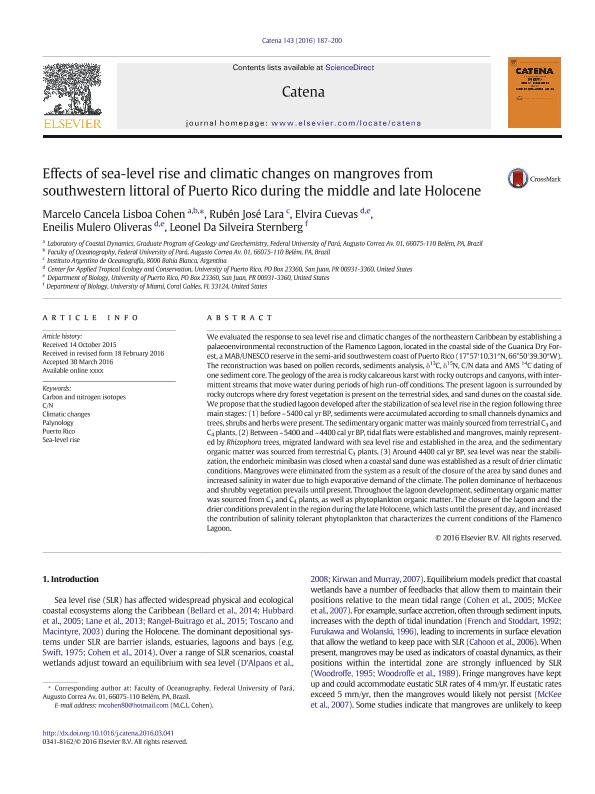Artículo
Effects of sea-level rise and climatic changes on mangroves from southwestern littoral of Puerto Rico during the middle and late Holocene
Cohen, Marcelo Cancela Lisboa; Lara, Ruben Jose ; Cuevas, Elvira; Mulero Oliveras, Eneilis; Da Silveira Sternberg, Leonel
; Cuevas, Elvira; Mulero Oliveras, Eneilis; Da Silveira Sternberg, Leonel
 ; Cuevas, Elvira; Mulero Oliveras, Eneilis; Da Silveira Sternberg, Leonel
; Cuevas, Elvira; Mulero Oliveras, Eneilis; Da Silveira Sternberg, Leonel
Fecha de publicación:
08/2016
Editorial:
Elsevier Science
Revista:
Catena
ISSN:
0341-8162
Idioma:
Inglés
Tipo de recurso:
Artículo publicado
Clasificación temática:
Resumen
We evaluated the response to sea level rise and climatic changes of the northeastern Caribbean by establishing a palaeoenvironmental reconstruction of the Flamenco Lagoon, located in the coastal side of the Guanica Dry Forest, a MAB/UNESCO reserve in the semi-arid southwestern coast of Puerto Rico (17°57′10.31″N, 66°50′39.30″W). The reconstruction was based on pollen records, sediments analysis, δ13C, δ15N, C/N data and AMS 14C dating of one sediment core. The geology of the area is rocky calcareous karst with rocky outcrops and canyons, with intermittent streams that move water during periods of high run-off conditions. The present lagoon is surrounded by rocky outcrops where dry forest vegetation is present on the terrestrial sides, and sand dunes on the coastal side. We propose that the studied lagoon developed after the stabilization of sea level rise in the region following three main stages: (1) before ~ 5400 cal yr BP, sediments were accumulated according to small channels dynamics and trees, shrubs and herbs were present. The sedimentary organic matter was mainly sourced from terrestrial C3 and C4 plants. (2) Between ~ 5400 and ~ 4400 cal yr BP, tidal flats were established and mangroves, mainly represented by Rhizophora trees, migrated landward with sea level rise and established in the area, and the sedimentary organic matter was sourced from terrestrial C3 plants. (3) Around 4400 cal yr BP, sea level was near the stabilization, the endorheic minibasin was closed when a coastal sand dune was established as a result of drier climatic conditions. Mangroves were eliminated from the system as a result of the closure of the area by sand dunes and increased salinity in water due to high evaporative demand of the climate. The pollen dominance of herbaceous and shrubby vegetation prevails until present. Throughout the lagoon development, sedimentary organic matter was sourced from C3 and C4 plants, as well as phytoplankton organic matter. The closure of the lagoon and the drier conditions prevalent in the region during the late Holocene, which lasts until the present day, and increased the contribution of salinity tolerant phytoplankton that characterizes the current conditions of the Flamenco Lagoon.
Archivos asociados
Licencia
Identificadores
Colecciones
Articulos(CCT - BAHIA BLANCA)
Articulos de CTRO.CIENTIFICO TECNOL.CONICET - BAHIA BLANCA
Articulos de CTRO.CIENTIFICO TECNOL.CONICET - BAHIA BLANCA
Articulos(IADO)
Articulos de INST.ARG.DE OCEANOGRAFIA (I)
Articulos de INST.ARG.DE OCEANOGRAFIA (I)
Citación
Cohen, Marcelo Cancela Lisboa; Lara, Ruben Jose; Cuevas, Elvira; Mulero Oliveras, Eneilis; Da Silveira Sternberg, Leonel; Effects of sea-level rise and climatic changes on mangroves from southwestern littoral of Puerto Rico during the middle and late Holocene; Elsevier Science; Catena; 143; 8-2016; 187-200
Compartir
Altmétricas



